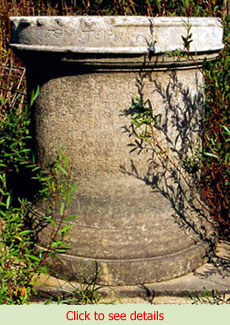The Temple of Apollo at Claros, which, in the Hellenistic and the Roman eras, was famous for its oracle, is situated on a flat track of land 2 kms to the north of the city of Notion. Today, the holy site is surrounded by orange groves. The gravel-paved road that extends from the area between the Ahmetbeyli village and its beach (Notion) gives access to the temple. The existence of a spring and a holy forest may be the reason behind the construction of the temple in this flat area. The holy cave near the temple indicates that the cult of Cybele was once practiced here. The temple of Apollo in Claros is mentioned in the lays of Homer.
The propylon, which is assumed to be the entrance to the temple, was discovered by Theodore Makridy in 1907. Between 1950-1960, Louis Robert, the famous french archaeologist and epigraphist, excavated the temple and its vicinity and introduced it to the world of science. Since 1988, the team under the leadership of Juliette de la Genière, a french professor, has first removed the soil from the previous excavations and then begun to unearth the area around the temple and the sacred road. In the process, the foundation of the ancient temple was discovered. Also, the restoration of one of the monuments and the monumental statues has been realized by the team.
The propylon, which is located at the start of the holy site, was constructed in the 2nd century B.C. It is in the Doric order and rests on a krepis with three steps

The names of the delegations that had come from Anatolia, Thrace and eastern Europe to consult the oracle of Apollo as well as the names of the children and young people who sang hymns to the god Apollo are inscribed on the columns, and the walls of the exedra.
On both sides of the sacred road that streches between the propylon and the temple, there are 1st century B.C. monuments which belong to the ancient cities of the time and the Roman governors of the Asian province.
The temple is in Doric order and measures 26 x 40 metres. Tall statues of Apollo, Artemis and Leto were found in the cella of the temple. These statues show that besides Apollo, his sister Artemis and his mother Leto were also revered here. The coins of Kolophon were used as a reference in the restoration of these statues. On these coins, Apollo is seen between his mother, Leto, on his left and his sister, Artemis, the hunter on his right. Artemis is depicted standing with her quiver on her shoulder.
The peripteros temple faces the altar in the east and has 11 columns on its long side and 8 on its short side. It rests on a krepis (stepped platform) with 5 steps. Its construction was started in the Hellenistic era, and according to the inscription on the architrave (lintel resting on columns) on the façade, it was completed during the reign of emperor Hadrien in the 2nd century A.D. The excavations carried on at the site since 1988 have revealed the existence of an older temple of Apollo and its altar under the present temple.There is another but smaller temple constructed parallel to the Temple of Apollo in the Hellenistic era. Only the remains of the foundation of this temple in Ionic order exists today. This temple with an altar is referred to as the Temple of Artemis because of the discovery of a statue of Artemis next to the altar.
The oracle used to deliver his revelations in the sacred area under the cella of the temple. Only the stone arches of this sacred area have remained. According to authors of the Hellenistic and Roman eras, unlike in Delphi where a female medium called Pythia was used to deliver the divine revelations, a male medium was used here. The oracle was consulted only at night. He used to enter a cave or an underground room and after drinking from the holy water there, he used to recite by heart the revelations written in verse by the writer (thespiodos). Each oracle could serve only for one year. Inscriptions of the Claros Apollo’s prophesies have been discovered in many of the cities of Hellenistic and Roman eras. Among these cities are Olbia in southern Russia, and Sivas, Amasya, Kayseri and Konya in Anatolia. Also in the Hellenistic era , the citizens of old Izmir asked the advice of Apollo in Claros before they moved to the new city of Smyrna in Kadifekale. During the reign of Augustus, a large temple was built for Claros Apollo in Sagalassos which was a Pisidian city.

